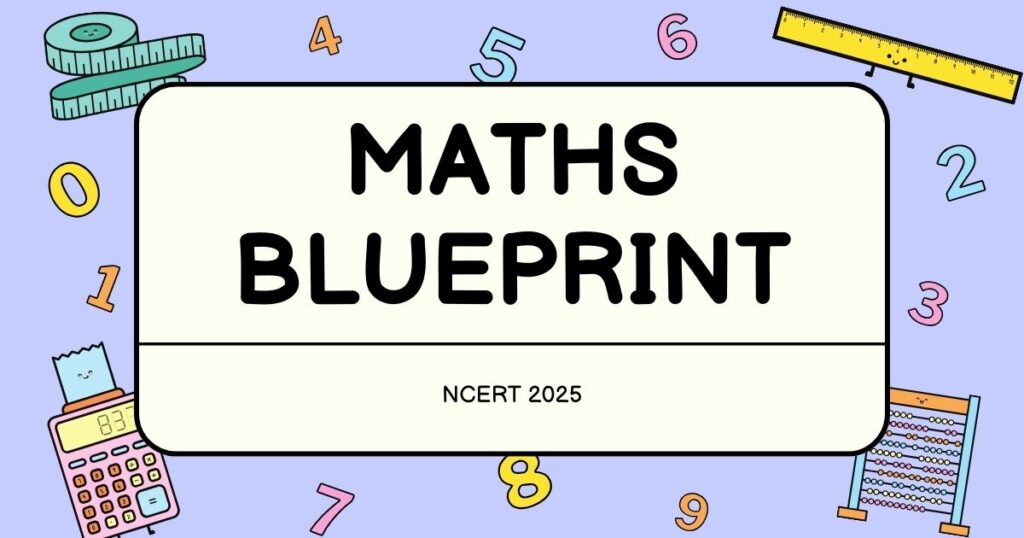
Scoring high in Class 10 Maths isn’t just about practice—it’s about smart preparation. Understanding the Class 10 Maths Blueprint 2025 gives students a clear roadmap to tackle the CBSE board exam with confidence. By knowing which chapters carry more weight and how questions are structured, students can focus their energy where it matters most.
Table of Contents
Class 10 Maths Blueprint 2025 – Chapter-Wise Marks Distribution
Here’s the latest breakdown based on the CBSE Class 10 Maths marking scheme for 2025. The blueprint includes unit-wise weightage and the expected number of questions from each chapter.
📊 Chapter-wise Marks Distribution Table
| Unit | Chapters | Marks |
|---|---|---|
| 1. Number Systems | Real Numbers | 6 |
| 2. Algebra | Polynomials, Linear Equations, Quadratic Equations, Arithmetic Progressions | 20 |
| 3. Coordinate Geometry | Coordinate Geometry | 6 |
| 4. Geometry | Triangles, Circles, Constructions | 15 |
| 5. Trigonometry | Introduction to Trigonometry, Applications | 12 |
| 6. Mensuration | Areas Related to Circles, Surface Areas & Volumes | 10 |
| 7. Statistics & Probability | Statistics, Probability | 11 |
| Total | 80 |
Note: Internal assessment (20 marks) brings the grand total to 100.
Question Types & Distribution
The question paper includes a mix of formats to test conceptual understanding and application:
- Objective Type (1 mark each): ~20%
- Short Answer Type I (SA-I) (2 marks each)
- Short Answer Type II (SA-II) (3 marks each)
- Long Answer (LA) (4 marks each)
Each section is balanced to evaluate calculation skills, problem-solving, and logic.
CBSE 10th Maths Exam Pattern – Overview
- Total Marks: 80 (Board Exam) + 20 (Internal)
- Time Duration: 3 hours
- Number of Questions: Around 30
- Sections: A, B, C, D based on difficulty and mark allocation
- Internal Choices: Provided in long and medium answer questions
This structure helps reduce pressure and allows students to focus on their strengths.
Smart Tips & CBSE 10th Maths Exam Strategy
Use the blueprint for Class 10 Maths as a prep tool, not just a guide. Here’s how:
🔑 Prioritize High-Weightage Units
- Focus more on Algebra, Geometry, and Trigonometry.
- Make sure to master problem-solving in these areas first.
📅 Plan a Chapter-Wise Study Schedule
- Assign study days based on marks. For example, spend more time on Algebra than on Coordinate Geometry.
⏳ Practice Time Management
- Use previous year papers and mock tests under timed conditions.
- Solve high-weightage chapters first during revision.
✅ Use the Blueprint to Check Readiness
- After covering a chapter, check how many marks it contributes. Revisit weaker but high-weight chapters.
Suggested Visual: Chapter vs Marks Bar Chart
To visualize the Maths chapter-wise weightage, create a simple bar chart showing each unit’s mark allocation. This can help students quickly see which units deserve more attention.
FAQs – Class 10 Maths Blueprint 2025
❓ What is the Class 10 Maths blueprint for 2025?
The blueprint outlines the chapter-wise marks distribution, types of questions, and structure of the CBSE Class 10 Maths board exam.
❓ How many marks are allocated to each chapter in Class 10 Maths?
Marks vary by unit. For example, Algebra carries 20 marks, Geometry 15, and Trigonometry 12. Full details are in the chapter-wise table above.
❓ Is the blueprint the same for the CBSE Term 1 and Term 2 exams?
No. In 2025, CBSE is following the annual exam system, so this blueprint applies to the full-year board exam.
❓ How can I score 90+ in Class 10 Maths using the blueprint?
Focus on high-weightage units, practice past papers, stick to the blueprint plan, and revise smartly using NCERT questions and examples.
Conclusion
The Class 10 Maths Blueprint 2025 isn’t just a map—it’s a strategy. Students who understand the blueprint can study smarter, reduce stress, and boost their scores. Start your prep early, use the blueprint to guide your schedule, and stick to the NCERT syllabus.
For official updates, always refer to the CBSE Academic Website.
